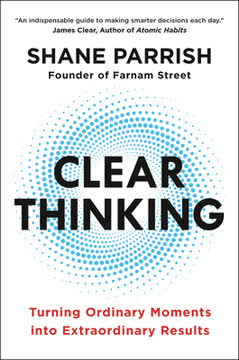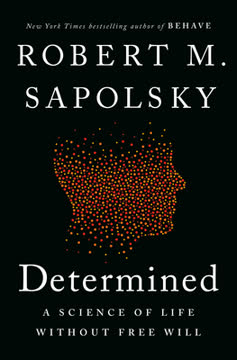Key Takeaways
1. Critical thinking is essential for navigating our complex world
"We have arranged a global civilization in which most crucial elements profoundly depend on science and technology. We have also arranged things so that almost no one understands science and technology. This is a prescription for disaster."
Information overload: In today's world, we are bombarded with an unprecedented amount of information from various sources. This deluge of data makes it increasingly difficult to separate fact from fiction, truth from falsehood.
Consequences of poor thinking: The inability to think critically can lead to dangerous outcomes, from falling for scams and misinformation to making poor health decisions or supporting harmful policies. Examples include:
- Believing in conspiracy theories
- Falling for pseudoscientific medical treatments
- Making decisions based on cognitive biases rather than evidence
Tools for critical thinking: To navigate this complex landscape, we must develop and hone our critical thinking skills. These include:
- Questioning assumptions
- Evaluating evidence
- Recognizing logical fallacies
- Considering alternative explanations
- Applying scientific skepticism
2. Logical fallacies distort our reasoning and lead to flawed conclusions
"The problem with logical fallacies is that they often give rise to sensible-looking conclusions, masking more serious issues."
Common fallacies: Many logical fallacies plague our thinking, leading us to draw incorrect conclusions even when our reasoning seems sound. Some prevalent examples include:
- Ad hominem: Attacking the person rather than their argument
- False dichotomy: Presenting only two options when more exist
- Post hoc ergo propter hoc: Assuming causation from correlation
- Appeal to nature: Believing natural things are inherently good
- Straw man: Misrepresenting an opponent's argument to easily refute it
Real-world impact: These fallacies can have serious consequences in various domains:
- Politics: Using false dichotomies to polarize debates
- Health: Relying on anecdotal evidence instead of scientific studies
- Economics: Drawing causation from correlation in market trends
Overcoming fallacies: Recognizing and avoiding these pitfalls requires:
- Studying common logical fallacies
- Practicing identifying them in everyday arguments
- Developing a habit of critically examining our own reasoning
- Encouraging others to point out flaws in our logic
3. Memory and perception are unreliable narrators of our experiences
"All of your memories are reconstructions, and to a greater or lesser degree there will be distortions in there."
Malleable memories: Our memories are not perfect recordings of past events but are instead reconstructions influenced by various factors. This malleability can lead to:
- False memories: Recalling events that never happened
- Memory distortion: Altering details of actual events
- Selective memory: Remembering certain aspects while forgetting others
Perceptual biases: Our perception of the world is also subject to various biases and illusions:
- Confirmation bias: Seeking information that confirms our existing beliefs
- Availability heuristic: Overestimating the likelihood of events we can easily recall
- Pareidolia: Seeing patterns or faces in random stimuli
Implications: The unreliability of memory and perception has significant consequences in areas such as:
- Eyewitness testimony in legal proceedings
- Personal decision-making based on past experiences
- Formation and maintenance of beliefs and worldviews
To mitigate these issues, we must:
- Be aware of our cognitive limitations
- Seek external verification when possible
- Remain open to revising our memories and perceptions
4. Statistics and probability are often misunderstood and misused
"While it is easy to lie with statistics, it is even easier to lie without them."
Common misunderstandings: Many people struggle with interpreting statistical information correctly, leading to flawed conclusions. Some frequent issues include:
- Confusing correlation with causation
- Misinterpreting relative vs. absolute risk
- Failing to consider base rates in probability
- Succumbing to the gambler's fallacy
Manipulation through numbers: Statistics can be deliberately misused to mislead or manipulate:
- Cherry-picking data to support a predetermined conclusion
- Using misleading graphs or visualizations
- Presenting statistics without proper context
- Exploiting innumeracy to promote false narratives
Improving statistical literacy: To better navigate a world filled with statistical claims, we should:
- Learn basic statistical concepts and probability theory
- Practice critical evaluation of statistical arguments
- Seek out multiple sources and interpretations of data
- Be wary of sensational statistical claims, especially in media headlines
5. Media and sources shape our understanding more than we realize
"Paper never refused ink, and the scientific ineptitude of the journalists, celebrities, and public figures engaged in such contemptible fearmongering was completely overlooked."
Echo chambers: In the digital age, we often find ourselves in information bubbles that reinforce our existing beliefs:
- Social media algorithms tailor content to our preferences
- We tend to seek out sources that confirm our biases
- Opposing viewpoints are easily avoided or dismissed
Media influence: Traditional and new media play a significant role in shaping public opinion:
- Sensationalism and clickbait can distort important issues
- False balance in reporting can give undue weight to fringe views
- Celebrity endorsements can lend credibility to pseudoscience
Critical consumption: To combat these influences, we must:
- Diversify our information sources
- Fact-check claims, especially those that confirm our biases
- Understand the business models and motivations behind media outlets
- Develop media literacy skills to identify manipulation and bias
6. Skepticism is crucial for distinguishing science from pseudoscience
"Falsifiability is fundamental to the scientific method. It insists that scientists not only look for corroborating observations but also actively test their ideas with the utmost scrutiny."
Hallmarks of science: True scientific inquiry has several key characteristics:
- Falsifiability: Theories can be proven wrong
- Reproducibility: Results can be replicated by others
- Peer review: Findings are scrutinized by experts
- Revision: Theories evolve as new evidence emerges
Pseudoscience red flags: In contrast, pseudoscience often exhibits:
- Unfalsifiable claims
- Reliance on anecdotal evidence
- Rejection of criticism or contrary evidence
- Appeal to conspiracy theories when challenged
Applying skepticism: To distinguish science from pseudoscience, we should:
- Ask for evidence and examine its quality
- Look for consensus among experts in the field
- Be wary of extraordinary claims without extraordinary evidence
- Understand the scientific method and its application
7. Analytical thinking can protect us from manipulation and conspiracy theories
"By simply being aware of potential errors in our reasoning, we can protect ourselves from detrimental consequences."
Power of analysis: Developing analytical thinking skills can:
- Help us evaluate claims more objectively
- Reduce susceptibility to manipulation and propaganda
- Improve decision-making in all areas of life
Combating conspiracy theories: Analytical thinking is particularly effective against conspiratorial ideation:
- It encourages consideration of alternative explanations
- Promotes evaluation of evidence quality
- Highlights logical inconsistencies in conspiracy narratives
Cultivating analytical skills: To improve our analytical thinking, we can:
- Practice breaking down complex arguments
- Learn about cognitive biases and how to mitigate them
- Engage in debates and discussions that challenge our views
- Regularly reflect on and question our own beliefs and assumptions
By honing these skills, we can better navigate the complexities of the modern world, make more informed decisions, and contribute to a more rational society.
Last updated:
FAQ
What's Good Thinking about?
- Exploration of Flawed Logic: Good Thinking by David Robert Grimes examines how flawed logic and reasoning can lead to dangerous societal consequences. It highlights the impact of cognitive biases and fallacies on decision-making.
- Critical Thinking Importance: The book emphasizes the necessity of critical thinking to combat misinformation and irrational beliefs. Grimes argues that understanding logical fallacies can improve personal and public decision-making.
- Real-World Examples: Grimes uses historical and contemporary examples, such as conspiracy theories and pseudoscience, to illustrate the impact of poor reasoning, making the book relatable and applicable to everyday situations.
Why should I read Good Thinking?
- Enhance Critical Thinking Skills: The book equips readers with tools to identify and counteract flawed reasoning in arguments. Grimes provides practical advice on thinking critically in an age of information overload.
- Understand Misinformation: Grimes offers tools to discern credible information from fallacies, making it a timely read for navigating today’s complex information landscape.
- Engaging and Accessible: Written in an engaging style, Grimes makes complex topics accessible to a broad audience, using anecdotes and humor to keep readers interested.
What are the key takeaways of Good Thinking?
- Recognizing Fallacies: A key takeaway is the ability to identify common logical fallacies, such as the post hoc fallacy and straw man argument, to critically evaluate arguments and claims.
- Importance of Evidence: Grimes stresses the significance of relying on evidence rather than anecdotes when forming opinions or making decisions, as anecdotes can be misleading.
- Role of Media: The book discusses how media can perpetuate bad thinking through sensationalism and misinformation, encouraging readers to be discerning consumers of information.
What are the best quotes from Good Thinking and what do they mean?
- “The road to hell is paved with good intentions.”: This quote highlights that actions without careful consideration can lead to disastrous outcomes, reminding readers to think critically about consequences.
- “If our leaders were forced to read this book, the world would be a safer place.”: This underscores the urgency of improving critical thinking skills in leadership for more rational and effective decision-making.
- “Extraordinary claims require extraordinary evidence.”: Quoting Carl Sagan, this emphasizes the principle of skepticism in evaluating claims, urging readers to demand robust evidence for implausible assertions.
How does Good Thinking address the role of media in shaping public opinion?
- Media Sensationalism: Grimes discusses how sensationalist media can distort facts and create panic, leading to widespread misinformation and poor public understanding.
- Echo Chambers: The book highlights the dangers of echo chambers, where individuals are only exposed to information that reinforces their existing beliefs, and encourages seeking diverse perspectives.
- Critical Consumption: Grimes advocates for critical consumption of media, urging readers to question the sources and motivations behind the information they encounter.
What methods does Grimes suggest for improving critical thinking?
- Awareness of Cognitive Biases: Grimes emphasizes recognizing cognitive biases that cloud judgment, enabling more rational decision-making.
- Evaluating Evidence: The book encourages prioritizing evidence over anecdotes when forming opinions, providing strategies for assessing evidence quality and relevance.
- Engaging in Reflective Thinking: Grimes advocates for reflective thinking, where individuals consider their beliefs and reasoning, leading to more informed conclusions.
What is circular reasoning as explained in Good Thinking?
- Definition of Circular Reasoning: Circular reasoning is a logical fallacy where the conclusion is included in its premises, making the argument tautological and providing no real evidence.
- Historical Context: Grimes discusses its use in theological arguments, where scripture is deemed true because it is written in scripture, reinforcing belief systems without substantive evidence.
- Impact on Belief Systems: This reasoning can reinforce belief systems without providing substantive evidence, posing a barrier to critical thinking and rational discourse.
What is motivated reasoning in Good Thinking?
- Definition of Motivated Reasoning: Motivated reasoning is the cognitive process where individuals interpret information to align with preexisting beliefs, often disregarding contradictory evidence.
- Cognitive Dissonance: Grimes connects motivated reasoning to cognitive dissonance, where conflicting information prompts rationalization rather than reevaluation of beliefs.
- Real-World Examples: The book illustrates motivated reasoning through issues like climate change denial, showing how deeply held beliefs can distort fact interpretation.
How does Good Thinking address the issue of echo chambers?
- Definition of Echo Chambers: Grimes defines echo chambers as environments where individuals are exposed only to information that reinforces their beliefs, leading to a skewed perception of reality.
- Impact on Society: Echo chambers contribute to societal polarization and hinder constructive dialogue, with dire consequences for public health and political discourse.
- Strategies to Overcome Echo Chambers: Grimes suggests seeking diverse perspectives and engaging with conflicting information to break out of echo chambers.
How does Good Thinking use real-world examples to illustrate its points?
- Sandy Hook Conspiracy Theories: Grimes examines these theories to highlight how misinformation spreads rapidly in echo chambers, illustrating real-world consequences of flawed reasoning.
- Anti-Vaccine Movement: The book discusses this movement as a case study in how misinformation can lead to public health crises, emphasizing the importance of scientific evidence.
- Historical Context: Grimes provides historical examples, such as Soviet disinformation campaigns, to show how misinformation manipulates public perception, underscoring the relevance of critical thinking.
How does Good Thinking address the impact of social media on misinformation?
- Amplification of Misinformation: Grimes discusses how social media platforms can amplify misinformation and create echo chambers, leading to widespread misconceptions.
- Role of Algorithms: Algorithms prioritize sensational content, entrenching users in their beliefs and creating a feedback loop that reinforces misinformation.
- Strategies for Responsible Sharing: Grimes encourages verifying sources and considering the impact of sharing unverified claims on social media.
How can I apply the lessons from Good Thinking in my daily life?
- Practice Critical Thinking: Engage in critical thinking when confronted with new information, questioning sources and seeking evidence before forming conclusions.
- Engage with Diverse Perspectives: Seek out diverse viewpoints to challenge beliefs, fostering understanding and reducing polarization.
- Stay Informed and Skeptical: Stay informed about current events and scientific developments, maintaining a skeptical mindset to discern reliable information from misinformation.
Review Summary
Good Thinking receives mostly positive reviews for its accessible explanation of critical thinking, logical fallacies, and cognitive biases. Readers appreciate the real-world examples and historical anecdotes used to illustrate concepts. Many find it eye-opening and valuable for improving reasoning skills. Some criticize the book's length and occasional repetitiveness. Overall, reviewers recommend it as an important read for understanding how to evaluate information and avoid flawed thinking in today's information-rich world.
Similar Books







Download PDF
Download EPUB
.epub digital book format is ideal for reading ebooks on phones, tablets, and e-readers.





